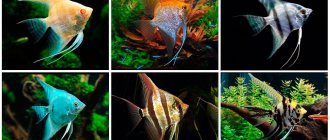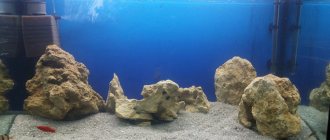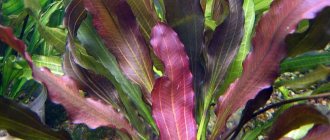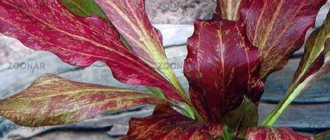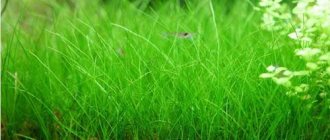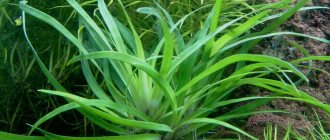The benefits of Echinodorus for the aquarium
Echinjdorus Ozelot is an artificially created plant. The “parents” of the ocelot were Echinodorus Schluteri Leopard and Barthii, crossed in Hans Barth’s nursery in 1995. Since then, this species has become the most popular aquarium plant.
The demand for the ocelot is explained by the benefits it brings to the inhabitants of the underwater world. Thanks to Echinodorus:
- water hardness decreases;
- the amount of harmful substances in the container is reduced;
- the fish have additional shelters and spawning sites.
The ocelot is unpretentious, able to adapt to various environmental conditions and is suitable for any pet that is not prone to eating vegetation.
Echinodorus dear Leonid Ilyich
The unique aquarium plant Echinodorus “dear Leonid Ilyich” has an attractive appearance and amazing qualities. Their leaves are characterized by increased rigidity and a certain thickness.
The leaves of adult plants have certain reliefs. Most of the leaves have a brown tint. White veins are distributed along the entire perimeter. The length of the leaves reaches 10 cm. The total height of the plant is 40–45 cm. The leaves dissolve in the middle layer of water.
For normal cultivation the following conditions are required:
- Liquid temperature in the container: from 22 to 25 degrees. Water changes are performed every 7–10 days (about 25 percent).
- A nutrient substrate is placed at the bottom, which promotes the normal development of the root system of the Echinodorus bartera plant.
- Vegetation is located in the central part of the tank so that it develops at a normal level.
General rules of care
Echinodorus ocelot is a rosette-shaped bush with a diameter of up to 50 cm. Large oval leaf plates are attached to powerful roots by cuttings. The plant can grow up to 40-50 cm in height. Therefore, the height of the aquarium should be at least 50 cm.
The size of the aquarium is of great importance due to the large dimensions of the plant itself.
The root system of the ocelot is branched. Therefore, you need to plant the bush as deep as possible. The dimensions of the aquarium must correspond to the dimensions of the plant. It is recommended to choose a container with a volume of 100-150 liters.
If you choose a smaller tank, the overgrown Echinodorus will take up the entire space. A container that is too tight will lead to the death of the crop.
The amount of water also matters. Low fluid levels provoke the formation of unsightly airy leaves.
Airy leaves of Echinodorus spoil the appearance of the plant and the aquarium as a whole.
The process of planting an ocelot in an aquarium is as follows:
- the plant is removed from the soil;
- remove small shoots from the rhizome;
- place the culture in the substrate;
- transferred to a tank for a permanent location.
Caring for an ocelot is simple, even inexperienced aquarists can do it. But, despite the fact that the plant is able to survive under unsuitable parameters, it is necessary to provide it with conditions for successful growth.
The crop is planted in a layer of soil mixture 8-10 cm thick. The substrate is prepared from a mixture of river sand, small pebbles and granite chips. It is also possible to use any one of these elements as a primer.
Echinodorus loves warmth and is able to survive in liquid heated to 30 ° C, however, this is the limit value and a lower temperature is recommended for permanent residence of the plant. The most acceptable water parameters are those presented in the table:
| Temperature (°C) | Acidity (pH) | Hardness (dGH) |
| 20-26 | 6 — 7,5 | 5-15 |
If the soil chosen for Echinodorus is well silted, then the use of additional fertilizing will not be necessary. The ocelot will have enough valuable elements formed naturally in an artificial reservoir. If the soil is not silted, nutrient balls made from a mixture of clay and charcoal or peat are placed under the rhizome.
Peat fertilizer for an aquarium should be used strictly according to the instructions.
It is recommended to plant Echinodorus in the center, away from other crops. Otherwise he will obscure them. When planting several specimens of the same species, the bushes are placed at some distance from each other.
Difficulties in care, planting and reproduction
Being generally hardy representatives of the plant world, Echinodorus are rarely susceptible to disease, but there are still certain difficulties when caring for this type of plant. A number of requirements include:
- Intense lighting (for some - over 0.7 W/l; extended daylight hours up to 11-14 hours).
- Nutritious fine fraction substrate (sand or pebbles with or without the addition of pieces of clay and boiled peat under the rhizome, depending on the root system). Often among the descriptions of conditions there is well-silted soil of a certain height. They require periodic application of microfertilizers (selected strictly individually), and some require additional CO2 supply.
- Regular replacement of part of the water, cleaning of the soil.
- Temperature – most often +20…+28 °C. Neutral pH, medium water hardness. However, there are individual preferences.
- It is advisable to periodically replant the plant. At the same time, varieties with a powerful rhizome require more frequent replanting than those that do not form one.
Propagation mainly occurs by daughter plants, but some species are still capable of propagation by seeds and (or) division of rhizomes.
Lighting as the most important factor
One of the features of the ocelot is the ability to grow even in the shade. The lack of bright light does not affect the color and pattern of the leaves. But the plant still needs lighting. With natural light lasting from 6 to 10 hours, the color of the bushes becomes richer.
Artificial lighting is created by fluorescent lamps. Devices with predominant blue, green, and yellow rays are best suited. The power of the lamps is selected at the rate of 0.5 W per 1 liter of water.
It is better to install the lamps so that the light falls from above. Side lighting makes the bushes more spreading and sparse. In addition, this provokes the formation of lateral daughter plants, which inhibit the development of the mother bush.
Correctly selected lighting ensures the maintenance of photosynthesis. You can determine whether the ocelot has enough light by the appearance of the bushes. Sufficient light stimulates the appearance of new leaves. At the same time, the stems remain short. A lack of light leads to elongation of cuttings and changes in leaf color.
Echinodorus St. Elmo's fire
The St. Elmo's fire plant is planted in containers with purified water. In order to eliminate the accumulation of organic residues and waste products, the tank is equipped with compressors and aeration devices.
For the normal development of St. Elmo's fire plants, powerful lighting equipment is required, which is equipped with fluorescent lamps. After all, whether the plant will develop normally depends on how high-quality the lighting is.
Among the decorative qualities of this plant are:
- The bottom of the aquarium is filled with silted substrate. Its thickness is about 2–3 cm.
- The growth of an aquarium plant does not stop throughout the year.
- The temperature of the liquid in the container is about 22 degrees.
- The container with this plant is equipped with a high-quality filter, which removes all impurities.
Kinds
The species diversity of ocelots includes more than 50 varieties. Most of them are cultivated in home ponds.
The most common types of Echinodorus:
Horizontal
Pistachio-colored leaves in the shape of a heart or egg are attached to the cuttings at an angle of 90°. Plant height is 25 cm. It grows at a temperature of 22-28°C; in autumn and spring, the temperature regime must be reduced to 20-22°C.
Mottled
Greenish leaves with coffee specks. The height of the bush is from 10 to 20 cm. The optimal temperature is from 24 to 28°C. At lower temperatures, bush growth stops. Demanding on lighting. A lack of light leads to the disappearance of specks.
small-flowered
The lance-shaped surface of the dark green foliage is dotted with brownish veins, for which it is nicknamed the “Black Amazon”. Quickly adapts to a decrease in temperature from 20-27 to 17-18°C and hardness within 2-20dH. The most popular varieties are Echinodorus parviflora tropica and parviflora parviflora. The distinctive qualities of the tropics are corrugated sheet plates. Parviflorus tropica grows up to 40 cm in height. The size and color of the leaves depends on the light. When the daylight hours are more than 10 hours, the leaves become light green.
Aflame
Compact plant with bright purple leaves. High maintenance requirements. Water characteristics: t – 22-28°C, dH – from 2 to 15, pH – 6-8. When planting, a nutrient substrate is required.
Argentinian
A giant plant growing up to 100-120 cm, with green, dense, oval leaves. Water: t – 17-25°C, pH – 6.5-7.5. The rigidity can be any. Breeding in an artificial reservoir is impossible, since the rhizome does not produce daughter shoots.
Narrow-leaved
A hardy, heat-loving representative of the species with narrow, greenish foliage, reaching a length of 0.6 m, tapering towards the top. Prefers slightly acidic water at a temperature of 22-27°C.
Osiris (osiris)
With wide, elongated foliage, gathered into rosettes. The leaves turn from light chestnut to dark green as they develop. Equally loves both soft and hard water. To ensure plant growth, a nutrient substrate is placed under the rhizome.
Rubra
Subspecies of Echinodorus tender. Small bushes with leaves up to 10 cm long and 2 mm wide. A slightly reddish stripe runs down the center of the dark green foliage. The gentle rubra loves bright light and fine-grained, nutritious soil.
Schluter
It stands out for its ellipsoid leaves, colored in a lush green tone with reddish specks. Water temperature – 21-25°С, lighting – moderate.
Red
Representatives of this species include varieties Ruby, Rose, Red Ocelot, Red Flame, Indian Red. At a liquid temperature of up to 15°C, the bushes acquire a crimson color. It is recommended to feed the plants with liquid fertilizers.
Dark Beauty
Hybrid with ovate burgundy foliage. Reaches 20 cm in height. In order for the leaves to acquire a bright color, intense lighting is required.
Latifolius
The leaves are narrow, elongated, colored light green. Requires bright lighting, additional CO2 and nutrient-rich soil. Otherwise the foliage turns yellow.
Red Devil
The lance-shaped foliage is ruby red. t – 25-30°С, dH – up to 25, pH – 5-8. It is recommended to choose sand mixed with clay as a soil mixture.
Vertical
A short stem, reaching a length of 0.2 m, a dense rosette consisting of olive oval leaves.
Florence or Veronica
A large plant that produces up to 35-40 short petioles, dotted with many leaves. As the bush develops, the leaves change color from reddish to olive. The bushes are picky about their maintenance conditions and require regular feeding with fertilizers and the supply of carbon dioxide.
broadleaf
Bushes of a rich green hue, growing up to 0.15 m. Maintenance requirements - warm water of neutral acidity, moderate lighting. Feels good in a nutritious substrate.
Bolivian
It is cultivated both in aquariums and in greenhouses. Leaf length – 100 mm, width – 6-8 mm. It grows quite quickly and blooms often, producing erect inflorescences. It has no special requirements for content.
There is a group of Echinodorus bred in a hybrid way by amateur breeder Igor Filippov.
Among them are plants:
- With green coloring - Supreme Landscaper, Thundering, Green Firefly, Your Grace.
- Red - Michurinets, Maghribians, Bloody tourists.
- Brown shades – Sine, Merciless, Intelligent.
- A mixture of greenish-reddish shades - Nazgul.
Inexperienced aquarists are recommended to grow such species of Echinodorus as: viridis, muricatus, apart, quadricolor, wisp, little prince, mercedes, bolivian, marble queen, red special, sellovianus, red pearl, green ocelot. These plants do not require special care. It is only important to provide them with a nutritious substrate and bright lighting.
Goreman, goreman and opacus are more demanding in terms of content.
Echinodorus by Igor Filippov
Echinodorus Igor Filippov are decorative aquarium plants that have a unique appearance. The leaves of these herbs have a sinusoidal shape. That is why you can come across another name - sinusoid.
The hue of a plant such as green firefly echinodorus changes as it grows larger. Small plants have leaves that are soft green in color. Height reaches 30 cm.
For normal development of vegetation it is required:
- Weekly fluid changes in the reservoir (about 30 percent).
- Liquid temperature is from 24 to 26 degrees.
- Acidity and hardness are at an average level.
- The bottom of the container is filled with nutrient substrate. For normal development of the root system, periodic introduction of nutrients is required.
Breeding
Reproduction of Echinodorus is carried out vegetatively. One of the peculiarities of the culture is the absence of stems. The foliage grows directly from the rhizome. Rhizomes are formed on the root system - seals that release buds, from which stepchildren later grow.
But for the ocelot, this process is slightly different. Its reproduction occurs by arrows, which are released by the mother bush.
After a new rosette grows and 5-6 leaves appear on it, the daughter plant is separated from the parent plant and planted in the ground. It will take a little time to adapt to the new outlet. Having taken root, the young bush begins to actively develop.
Reproduction of Echinodorus occurs by dividing daughter shoots. It is difficult to collect the seeds of a flowering plant at home, but it is even more difficult to grow a seedling from them.
Propagation of Echinodorus by seeds is almost impossible. Despite the fact that the plant can produce flower shoots, full-fledged seeds are rarely formed. You can try to artificially pollinate the bushes with a soft brush. To do this, you need to wait until the fruits are fully ripened. The collected seeds are further dried for 1-2 months. Then they are sown in containers with wet sand.
Luxurious Echinodorus ocelot bushes will decorate any home pond. The plant is easy to care for and goes well with a variety of underwater pets.
Description and features
Echinodorus is native to America. This plant belongs to the Chastukhov family. Reproduction occurs vegetatively and less commonly by the root system. Among Echinodorus, there are both annual and perennial species.
The plant also differs in its external characteristics. Some types of Echinodorus reach a height of more than a meter, while others do not exceed 5 cm. The leaf blades of the plant can also have a variety of shapes and colors. Such a variety of shapes and colors makes it possible to create a magnificent, unique aquarium design.
This plant is conventionally divided into several main groups:
- surface;
- floating;
- underwater.
In terms of care and maintenance conditions, echinodorus are divided into complex and simple. The first group is suitable for experienced aquarists, while simple plant species can be planted by beginners.
Echinodorus devil's eye
Echinodorus devil's eye is an aquarium plant whose leaves are shaped like boats. The color of the leaves ranges from green to bright red. Their edge is brown.
The color of the leaves does not change over time. The only thing that changes in low light is the fiery frame.
The content requires the following conditions:
- The temperature of the liquid in the aquarium is 22–25 degrees. Water changes are performed every 6–10 days.
- A nutrient substrate with a certain amount of minerals is placed at the bottom of the container.
- Acidity and hardness are at an average level.
How to plant
Small-sized echinodorus can be planted in the center or along the edges of the aquarium, large representatives - at the back wall of the tank or in separate pots.
Rules for planting in the ground:
- First, inspect the plant, carefully remove damaged leaves and roots. Then it needs to be disinfected for 20 minutes in a weak solution of potassium permanganate or rinsed in a solution of hydrogen peroxide (1 tsp/1 l).
- Dig a small hole in the soil, place a ball of clay for better growth, carefully place the root and cover with soil.
Rules for planting in pots:
- You will need a small pot 7-8 cm high, in which you need to drill holes.
- Place a mixture of garden soil and fine gravel on the bottom, place a ball of clay, then a plant and carefully cover with fine gravel or sand.
Echilodorus grows quickly and has a powerful root system, and when planted in pots, it will need to be transplanted into larger containers every 6-12 months.
Echinodorus parviflora
Supreme Landscaper
Among aquarium plants, the supreme gardener deserves special attention. After all, their leaves are distinguished by a bright emerald hue. The leaves are distinguished by increased density and the presence of veins.
The Supreme Landscaper is easy to keep. To fill the bottom, a substrate with nutrients and useful components is used.
For the normal development of the plant, the supreme gardener requires a voluminous tank, which has a large area. The lid of the container must be supplemented with lighting equipment. The duration of daylight hours is 10–12 hours.
The supreme gardener rarely produces the arrows that are necessary for normal propagation.
The height of the supreme gardener plant reaches 25–30 cm. It grows in the form of a bush, so the central part of the aquarium is allocated for its placement.
Echinodorus firefeather
Dancing feather is a fiery aquarium plant that was bred artificially. In order for the dancing feather plant to develop normally, the following conditions must be observed:
- Those tanks that are prepared for the dance plant are equipped with lighting devices with fluorescent lamps.
- A nutrient substrate 2–5 cm thick is placed at the bottom of the aquarium.
- The tank dimensions are about 250–300 liters. After all, the height of the dancing feather plant reaches 50 cm.
Periodically, an aquarium with such vegetation is cleaned using a compressor and a filtration unit.
Echinodorus in the aquarium is an ideal option for beginners and experienced aquarists. After all, caring for them is easy. It is enough to choose the right container and regularly change the water in the container.
Video about the development, reproduction and transplantation of echinodorus
AdminAuthor of the article
Did you like the article?
Share with your friends:


